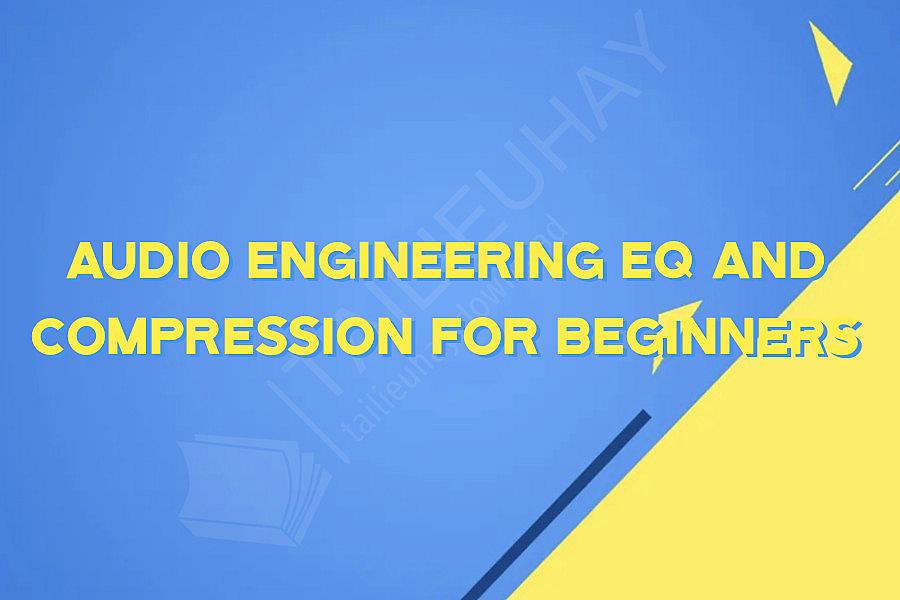audio engineering EQ and Compression for beginners

Audio engineering is a complex field that involves a multitude of techniques and tools. Two of the most important tools in audio engineering are EQ and compression. EQ (Equalization) is used to adjust and balance the frequency spectrum of a track, while compression is used to control the dynamics of a track. EQ and compression help in achieving a high-quality sound for any audio recording, mix or master. In this article, we will provide an introduction to EQ and compression for beginners.
EQ stands for equalization, which is the process of adjusting the frequency response of an audio signal. EQ is used to balance the frequency content of a track, by boosting or cutting certain frequencies. Equalization can be done in many ways, including using a graphic equalizer, parametric equalizer, or filters. Each of these methods has its advantages and disadvantages, but the end goal remains the same: to achieve a balanced yet unique frequency response that complements the mix.
EQ can be used to solve many issues, such as a lack of presence in a vocal or an excess of bass in a drum loop. To use EQ effectively, it's important to understand the frequency spectrum and how different frequencies affect a sound. For example, an acoustic guitar has a rich frequency range between 80Hz-2kHz, and an EQ can be used to enhance those frequencies to achieve a warmer sound. Similarly, removing the unwanted frequencies of a sound can clean up a mix and make it sound clearer.
Compression is another critical tool in audio engineering. Compression is used to control the dynamic range of a track, by reducing the difference between the loudest and quietest parts of a recording. A compressor works by reducing the volume of the loudest parts of a track, while maintaining the overall balance between different elements in the mix.
Compressors come in various types, such as VCA, Opto, and FET compressors, each with a different sound character. Generally, compression is used to bring out the detail in a track and make it sound more cohesive, glued, and polished. Compression can also be used creatively to achieve specific effects, such as a pumping bassline in a dance track.
In conclusion, EQ and compression are essential tools in audio engineering. EQ helps to balance the frequency content of a track, while compression controls the dynamics. By using EQ and compression effectively, you can enhance the quality and clarity of your mixes. However, it takes practice and experience to get good at using these tools. So, start experimenting with them and keep your ears open. Always remember that the best decisions are made by listening to your ears and trusting them.
EQ stands for equalization, which is the process of adjusting the frequency response of an audio signal. EQ is used to balance the frequency content of a track, by boosting or cutting certain frequencies. Equalization can be done in many ways, including using a graphic equalizer, parametric equalizer, or filters. Each of these methods has its advantages and disadvantages, but the end goal remains the same: to achieve a balanced yet unique frequency response that complements the mix.
EQ can be used to solve many issues, such as a lack of presence in a vocal or an excess of bass in a drum loop. To use EQ effectively, it's important to understand the frequency spectrum and how different frequencies affect a sound. For example, an acoustic guitar has a rich frequency range between 80Hz-2kHz, and an EQ can be used to enhance those frequencies to achieve a warmer sound. Similarly, removing the unwanted frequencies of a sound can clean up a mix and make it sound clearer.
Compression is another critical tool in audio engineering. Compression is used to control the dynamic range of a track, by reducing the difference between the loudest and quietest parts of a recording. A compressor works by reducing the volume of the loudest parts of a track, while maintaining the overall balance between different elements in the mix.
Compressors come in various types, such as VCA, Opto, and FET compressors, each with a different sound character. Generally, compression is used to bring out the detail in a track and make it sound more cohesive, glued, and polished. Compression can also be used creatively to achieve specific effects, such as a pumping bassline in a dance track.
In conclusion, EQ and compression are essential tools in audio engineering. EQ helps to balance the frequency content of a track, while compression controls the dynamics. By using EQ and compression effectively, you can enhance the quality and clarity of your mixes. However, it takes practice and experience to get good at using these tools. So, start experimenting with them and keep your ears open. Always remember that the best decisions are made by listening to your ears and trusting them.
Khóa Học Cùng Chủ Đề
After Effects Essentials
Build a Recommendation Engine
Complete ASP.NET Core 0 MVC Single-Page App[The FUTURE]
Complete Blockchain, Cryptocurrency, Wallet Development
Complete Ruby on Rails Single-Page App [The FUTURE]
Getting Started with Maya 2017
Musketeers App online roulette numbers forecasting App
Premiere Pro 101
SQUATS FROM A TO Z
The Maxx You Project How To Capture an Authentic You
12 Small Programs in Java
3ds max making of subway train
7 Scientifically Proven Steps to Increase Your Influence
Adobe Flash CS5 for Beginners
Adsense Masterclass 2018